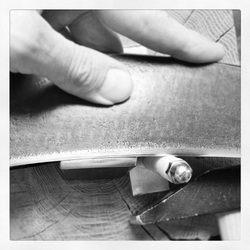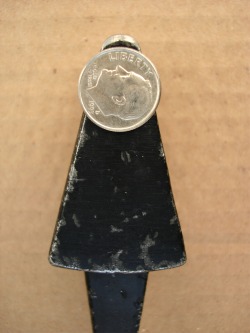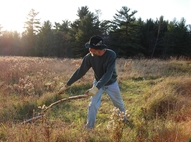 Peening a scythe blade. Peening a scythe blade. The first Sunday of April has been officially dubbed International Peening Day, by the Scythe Association of the British Isles. The idea was originally conceived by Steve Tomlin, to encourage people to take the time to properly prepare their scythe blades for the upcoming mowing season. Even better is when people gather in small groups, to share their knowledge and experience. It falls on Easter this year, April 5th.1SR Scythe Instructor Andy Graybeal is hosting such an event in Coolville, Ohio. Andy will help those who need assistance getting their blade sharp. Starting at noon. Rain or shine. Contact Andy at [email protected], if you want to attend, or register on Facebook at https://www.facebook.com/events/928546020509355/ I will be hosting an event in Minnesota, near Hastings. Contact me at [email protected], or call 651-604-7090 if you wish to attend. Bring your scythe blade, whetstones, and whatever peening gear and stump you have. If you participating in the international event, either in groups or on your own, you are invited to share pictures with Steve Tomlin https://stevetomlincrafts.wordpress.com/2015/03/08/international-peening-day-2015/ - Botan Anderson
0 Comments
 Just got these peening guides back from our local machine shop. I spent many hours over the past couple of weeks, in hardware stores trying out all kinds of combinations of aluminum bars, and nuts, bolts, washers, and spacers, until I finally came up with a combination and design that worked. Then I had a local machine shop cut the aluminum pieces, router out the slots, drill and thread the screw hole, and chamfer all the edges. They did a beautiful job. The finished product is sleek, and works wonderfully.  A narrow, or bar peen anvil, needs to have a rounded face. How rounded should it be? Preferences vary with peening techniques. The amount of roundedness is called the radius. Since all rounded narrow anvils are rounded off by hand (not cast), it's an approximation that can vary slightly between individual anvils, and considerably with entire batches from year to year. The amount of radius makes a huge difference in how the anvils peens, yet no one that sells scythe anvils ever describes it. I've been trying for years to think of a way of classifying the amount of radius on a narrow anvil. Measuring the radius in actual mm is hard to relate to unless you're an engineer. Also, I don't have a metric radius gauge, and haven't come up with one yet. Classifying the radius as narrow, medium, or wide seemed too vague and relative, without a method of measurement. So I thought of comparing the radius to a common standard sized object. The best thing that I could think of was a U.S. dime, which has a radius of 9mm. According to engineer Gerhard Wagner of the SFX factory, a radius of 9-12mm on a narrow anvil is classified as a "blunt" anvil. 6-8mm is a "normal" anvil, and 4-5mm is a "sharp" anvil. The Picard anvil pictured above, looks like it has a radius at the narrower side of the "normal" spectrum. The commonly available Czech-made "babbka's", are not rounded, but they are soft enough to shape a radius to your liking. Good luck doing that with the Picard, or the 60 Rockwell SFX anvil! |
Botan AndersonArchives
March 2023
Categories
All
|

 RSS Feed
RSS Feed